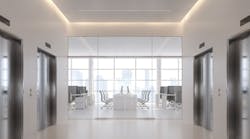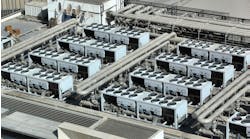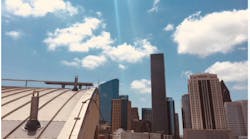Inefficient buildings waste revenue directly and indirectly. Building owners whose buildings needlessly consume too much energy will have higher utility bills than competitors.
Some of the revenue must be used to pay for the energy the building consumed. Inefficient building systems also affect future earnings by taking away funds that could have been used to refresh common areas or upgrade tenant-facing technologies.
An intelligently designed building minimizes energy usage and waste and maximizes savings.
Why Efficient Design Matters
HVAC and vertical transportation are prime candidates for design upgrades. HVAC accounts for 30-40% of the average building’s energy use, according to the Energy Information Administration. Specifying a highly efficient HVAC system will yield returns quickly.
Elevators and escalators only use an estimated 3-5% of a building’s total electricity demand, according to the American Council for an Energy Efficient Economy (ACEEE). However, there are two key reasons to upgrade to a more sophisticated vertical transportation design.
1. Better vertical transportation specifications have an outsized efficiency impact. Elevators and escalators in existing buildings are usually not updated frequently, and their energy consumption is not regulated. Choosing a more efficient product upfront can pay financial dividends for years to come.
2. Owners may have more rentable square footage. Some vertical transportation products need less room than others. Machine-room-less (MRL) elevators, for example, can save square footage just by eliminating the machine room requirement. In some cases, building owners may be able to reduce the number of elevators and escalators they specify.
Inefficient systems—especially HVAC—are often uncomfortable as well. Think of your last hotel stay. Did it have a wall unit that cycled constantly and seemed to only have very hot or very cold temperature settings? Guests often dislike such units because they are noisy and uncomfortable. They are also typically old and inefficient, so hotel owners lose money twice by overpaying for energy and then for unsatisfied customers.
BUILDINGS Podcast
Looming and Potential Financial Risks with Commercial Building Systems
The conversation around vertical transportation and uninterruptible power supplies often centers around efficiency and resilience, but there’s much more at stake with both of those systems—namely, the risk of major loss. Listen now >>
Owners of leased office buildings lose money in a similar way. Tenants are more likely to leave at the end of their lease if their employees are constantly uncomfortable. They also may be responsible for their share of the building’s energy costs, so inefficient design can leave tenants with higher bills.
No building has to operate like this. Design for efficiency by implementing tenant-friendly features that also save money.
4 Efficient Design Strategies
Efficient design does not have to mean a sizable increase in your project budget. Investments in the right places can keep building occupants comfortable and happy while performing efficiently. Consider these four upgrade ideas.
1. Change the way you dispatch elevators.
Destination dispatch elevators use an intelligent control system to group people into elevator cars depending on their destination. The system determines which car should respond to a request depending on waiting time, travel time, occupancy and other factors. People who board can go directly to their destination rather than stopping at several floors on the way to drop off other passengers.
The flexible car allocation is so efficient that you may be able to install fewer elevators, which both reduces your building’s energy consumption and yields additional square footage that better used to generate revenue.
2. Capitalize on low demand periods.
Implement systems that perform efficiently under part-load conditions. Start with a high-performance HVAC unit with a high coefficient of performance (COP), a rating that measures how much heating or cooling is generated compared to how much work is required to generate it.
Then, pair that HVAC unit with an equally energy-efficient technology like variable refrigerant flow (VRF), which circulates varying amounts of refrigerant only as needed to meet demand. This is useful because many spaces do not need the maximum amount of cooling, so the system does not have to work as hard in those spaces.
Tenants tend to find them more comfortable because they are no longer limited to either heating or cooling. The same VRF system can deliver heating to one office and cooling to another.
Variable frequency drives (VFD) controls can further boost your savings. This technology throttles back how hard pumps and fans work to circulate air or coolant during part-load conditions.
3. Implement technology that offsets its own consumption.
MRL elevators with gearless traction use a regenerative converter. This technology transmits the power generated by the traction machine back to the distribution transformer and into the building’s electrical network, where it mixes with grid electricity. The power from operating the traction machine is typically dissipated as heat, but collecting and using it offsets about 35% of the elevator’s energy consumption, according to Mitsubishi Electric.
4. Stay on top of maintenance.
Protect your investment with a regular maintenance program. Just sealing your heating and cooling ducts can improve HVAC efficiency by 20% or more, according to California utility company Pacific Gas & Electric. Replace parts before they fully fail to avoid expensive downtime and keep the system operating at maximum efficiency.
Intelligent building design has an important impact on energy efficiency, and ultimately, your bottom line. Learn more about designing for efficiency at buildbettertogether.com.
Read more: The Steep Cost of Unplanned Downtime


